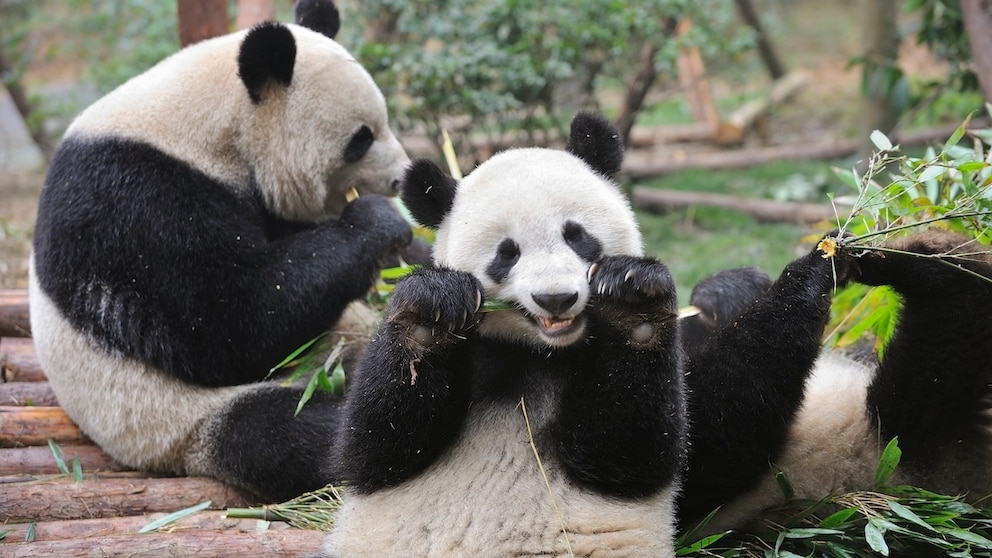March 4, 2025, 9:36 am | Read time: 4 minutes
Of the eight large bears still alive today, only one is vegan. A study shows why the panda was able to adapt to a diet of bamboo, even though its metabolism is designed to eat meat.
Bears are actually omnivores that opportunistically feed on what surrounds them. In the case of brown bears, this is initially grass in spring, later berries and nuts, but especially fish in preparation for winter. Other bears do not stop at termites (Malayan bears) or even seals (polar bears). The only one of the eight real bears that has surprisingly become a vegan is the giant panda. A study has now discovered how their metabolism, which is designed to digest meat, has been altered by bamboo consumption.
Pandas Have Fully Adapted Their Diet to Bamboo
The diet of the giant panda (Ailuropoda melanoleuca) is a biological paradox. Although it belongs to the Carnivora — and this can be seen from its relatively short metabolic organs, which are designed to utilize protein — it feeds almost exclusively on bamboo. This low-energy, hard-to-digest plant should actually lead to severe malnutrition.
However, scientific studies have shown that pandas have developed genetic adaptations to this unusual diet. This includes the development of special intestinal bacteria that help digest the plant food and various glands that enable optimal utilization of the hard fibers. The umami taste receptor is also inactive in pandas, so they are not bored by the neutral taste of bamboo when eating.
Pandas also have a modified thyroid gland, which produces fewer hormones and guarantees lower energy consumption for the whole organism. Now, a new study reveals another previously unknown mechanism: micro-plant RNA (MiRNA) enters the bloodstream of pandas and influences various genes there.
The study was based on RNA sequencing of miRNAs from the blood of a total of seven pandas and the three bamboo species studied. Researchers analyzed the blood of three panda groups (males, females, and female cubs not yet sexually mature ), which was taken during routine veterinary checks. From these samples, the researchers isolated so-called exosomes — small vesicles that transport miRNAs. The miRNAs they contained were then analyzed using high-throughput sequencing.
The Panda Is Quite happy as a Vegan on a Bamboo Diet
At the same time, various bamboo species (stems, leaves, shoots) eaten by the pandas were examined. The aim was to find out whether plant miRNAs can be detected in the pandas’ blood, whether they originate from the bamboo, and which genes they may influence.
The analysis revealed that 57 different plant miRNAs from bamboo could be detected in the pandas’ circulatory system. What is particularly striking is that many of these miRNAs influence genes associated with the sense of taste, dopamine signaling, and nutrient uptake.
- Sense of taste: Some miRNAs regulate bitter taste genes (TAS2R3), suggesting that pandas are particularly good at sensing bitter compounds in bamboo — a possible protective mechanism against toxic plant components.
- Dopamine metabolism: Several miRNAs influence dopaminergic signaling in the brain, including the expression of dopamine receptors (DRD4). This could explain why pandas develop a strong preference for bamboo and experience a “reward effect” and happiness from eating it.
- Digestion and nutrient uptake: Various miRNAs control genes that are important for digestion and energy utilization. For example, they influence the signaling pathways for starch and sugar metabolism as well as the absorption of nutrients from the intestine.
- Sex hormones from bamboo: The study also showed that male and female pandas had different miRNAs in their blood. Females had RNA associated with the formation of egg cells; males had RNA for cold tolerance of spermatozoa. Young, not yet sexually mature female bears, on the other hand, have a general base of miRNAs. They have probably absorbed these through their mother’s milk.

Cucumber, pumpkin, zucchini … Can cats eat vegetables?

Celebrity pet Lewis Hamilton feeds his dog a vegan diet: “I take care of his health”

According to the "Guinness Book of Records" This Is the Most “Bloodthirsty” Bird in the World
You Are What You Eat
The study shows, for the first time, that plant miRNAs enter the organism and actively contribute to gene regulation. For example, they are actively involved in the development from a carnivorous panda to a vegan. This is an important indication that nutrition is influenced not only by macronutrients such as proteins or carbohydrates but also at the molecular level by non-coding RNAs.
For panda research, this means that dietary adaptation is not only due to genetic mutations or intestinal bacteria but also to direct interaction with food components. The influence on dopamine metabolism is particularly exciting. If bamboo actually activates the pandas’ reward system, this could provide an evolutionary explanation for their exclusive preference and development into vegans.
The findings could also be relevant for species conservation. This is because, in many zoos, pandas are often fed a supplementary diet of wheat and corn products. The study actually also found miRNAs from these foods in the animals’ blood. This could indicate that modern feeding strategies can also influence gene expression and could lead to a change in captive pandas. Further studies are needed to clarify exactly what this means.1

